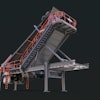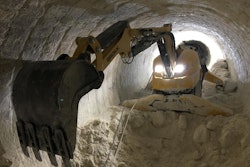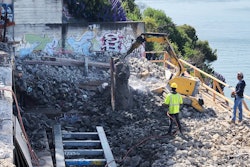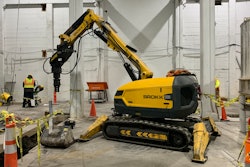
Alternative powered equipment is a hot topic right now. You can’t pick up a magazine without seeing an article about electric excavators, skid steers, telehandlers, wheel loaders, cars and more. With the world now paying attention, it’s easy to forget that other types of electric equipment have existed for years — and, in some cases, decades.
As many manufacturers have proven, it’s not overly difficult to come up with an electric model. Virtually all the large and midsize heavy equipment brands have at least one. The real challenge is optimizing performance, especially in heavy duty applications. Does the product have the power to get the job done? Can it make it through a shift?
Decades before these questions entered everyday conversation, demolition equipment manufacturers were innovating to meet demand for safer, faster ways to complete difficult, dangerous, labor-intensive tasks. Their solution was to mechanize manual processes and deliver a powerful but compact machine in an electric package. Today, these manufacturers have extensive experience engineering electric equipment and have optimized their machines for the best power and performance.
Remote-Controlled Demolition Robots
Demolition applications are demanding to say the least. They are dangerous. They often require the power of large equipment but pose a host of challenges that make it difficult to impossible to actually use it. Some of the common issues contractors contend with are limited access, confined spaces, low floor loads and nearby occupied spaces.
In the 1970s, there were not a lot of options for solving these kinds of problems. Confined access? Send in workers with hand tools. Confined access but overhead work? Put them on ladders or scaffolding with the hand tools. Too much noise? Deal with it. That’s the way it is. From the need for safer, more efficient demolition methods, the first remote-controlled demolition robots were born. While some diesel models are offered today, demolition robots started electric and remain electric more than 45 years later.
Today’s machines look like small excavators with a three-part arm that often wields a breaker, but can use a variety of attachments, including concrete crushers, scarifiers, shears, splitters, buckets, grapples and more. Robots range in size from 23.5 inches wide and 1,235 pounds to 84.65 inches wide and 25,133 pounds. The smaller robots can drive through a standard doorway, fit in a passenger elevator or even climb stairs.
But don’t let the compact size fool you. Demolition robots are engineered starting at the tip of the breaker for maximum hitting power. The result is that pound-for-pound, demolition robots provide the highest power-to-weight ratios in the industry, delivering the same results as an excavator three times the size. Combine that with a three-part arm, an electric-powered demolition robot offers exceptional reach and power in all directions, providing maximum precision and accuracy while the operator works from a safe position.
A variety of attachments further increase the value of compact electric power. Equip the robot with a shears attachment and efficiently and safely tear out concrete reinforcement, sprinklers, conduit, wire and cables. Or use a concrete crusher for “silent” demolition. The crusher attachment “chews” down a wall as opposed to using the force of a breaker to knock it down, reducing noise and vibration. For top-down applications where noise and vibration are primary concerns, crushers allow contractors to work during the day, sometimes without neighbors noticing.
These capabilities have years of experience behind them, making electric demolition robots the go-to for everything from soft demolition to refractory removal, ladle cleaning, underground mining, tunneling and many unique applications, such as driving helical piers.
Hydrodemolition Robots
Hydrodemolition robots were not far behind demolition robots. They were first developed in the 1980s to provide a better, faster way to remove large amounts of concrete. Like demolition robots, the first Hydrodemolition robots were electric models, with diesel models following.
If you aren’t familiar with Hydrodemolition, it is a concrete removal method that uses high-pressure water jets to penetrate pores and small cracks in the material and break it out. A significant benefit is that it can remove weak or damaged concrete while leaving good concrete intact. It is commonly used for repairs on bridges, parking garages, tunnels, dams and other concrete structures.
Back in the 1980s, Hydrodemolition manufacturers were innovating to improve a slow, difficult process that took a lot of manpower and was very hard on both the workers and the concrete structure. By harnessing the power of water, they developed an impact-free process that eliminated the vibrations that cause microfractures — miniscule cracks in sound concrete that can compromise the structure’s integrity. The high-pressure water jets also clean rebar and metal reinforcement without damaging it. And the process is much faster, with a single robot and operator achieving the same removal rate in a day as 20 jackhammer operators.
Today, the smallest models are electric while the large models are diesel, electric or hybrid with the use of a hybrid kit. The benefits of Hydrodemolition apply regardless what model a contractor uses, but there are certain situations in which an electric model is advantageous. A tunnel repair would be one of them. If diesel equipment is used, the contractor must provide a detailed plan for proper ventilation to win the bid and then implement the plan, which adds another layer of logistics and cost to the project. By using an electric Hydrodemolition robot, the contractor eliminates concerns about air supply and ultimately saves time and money.
Solutions also exist for contractors who need the capabilities of a large robot but are unable to use diesel power. Maybe the project is inside a building. The market offers bigger robots with an electric-powered option for these situations. Just like a diesel-powered Hydrodemolition robot, electric units can efficiently remove large amounts of concrete and reach horizontal, vertical and overhead areas up to 7 meters (23 feet) without support. On top of zero emissions, an electric-powered robot runs more quietly, making it an ideal option for projects with exhaust emission and noise restrictions.
Some manufacturers also offer hybrid kits that allow a diesel Hydrodemolition robot to run on electric power. The kit disengages the robot’s diesel engine, transforming it to an electric-powered machine, much like a hybrid car. This gives the contractor options, depending on what the project calls for, and provides a good back-up if the diesel power breaks down in the middle of a project. The contractor can simply plug in the hybrid kit to keep the operation moving.
Advancing Electric Technology
In the demolition world, electric solutions are nothing new. For many demolition and Hydrodemolition contractors, it’s just another day on the jobsite. Manufacturers have developed generations of electric robots, mastering electric power and offering highly sophisticated technology that is used for major projects around the world. For them, the question isn’t how to come up with a workable electric solution. It’s how an already well-developed electric solution can further increase safety, productivity and profitability.



















